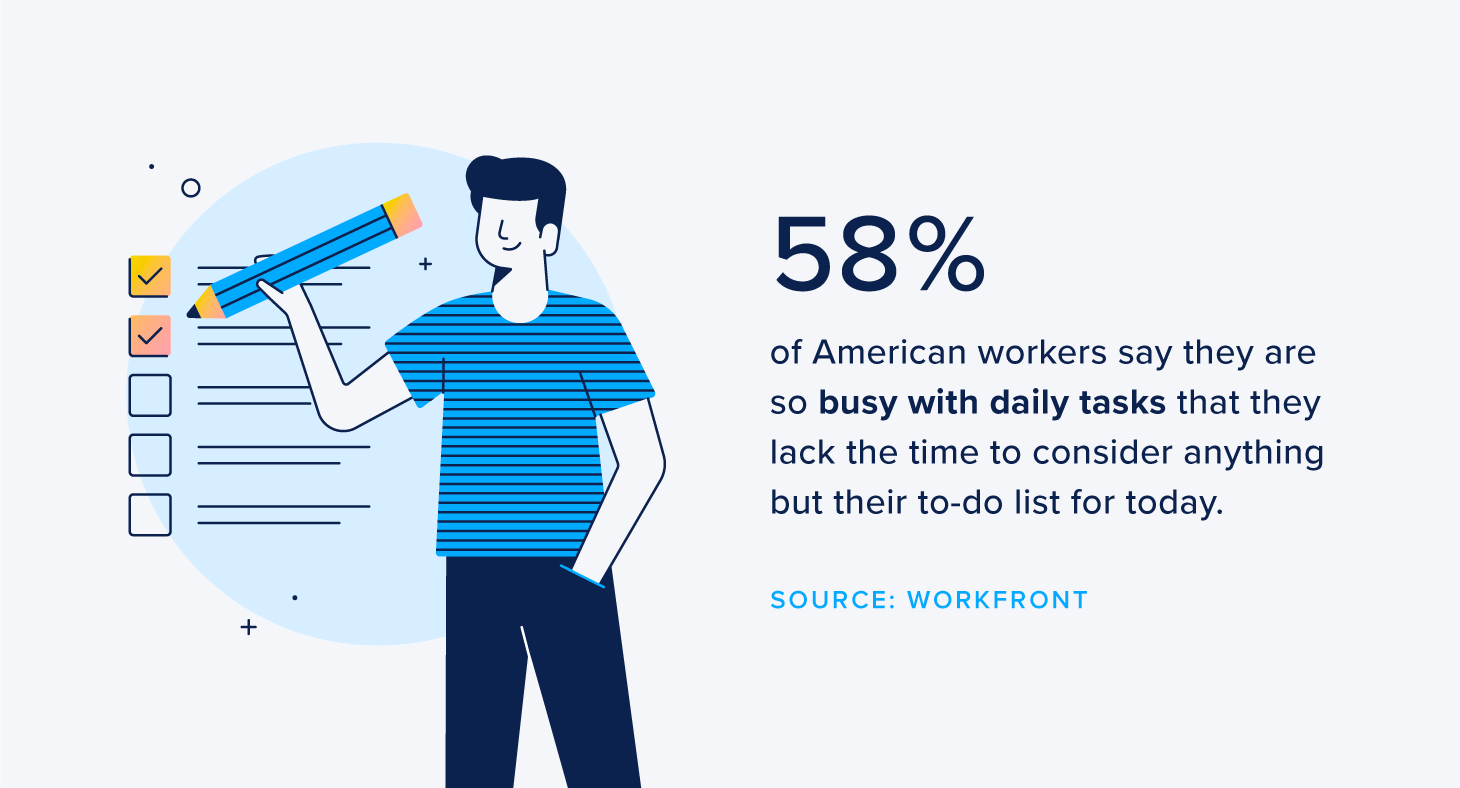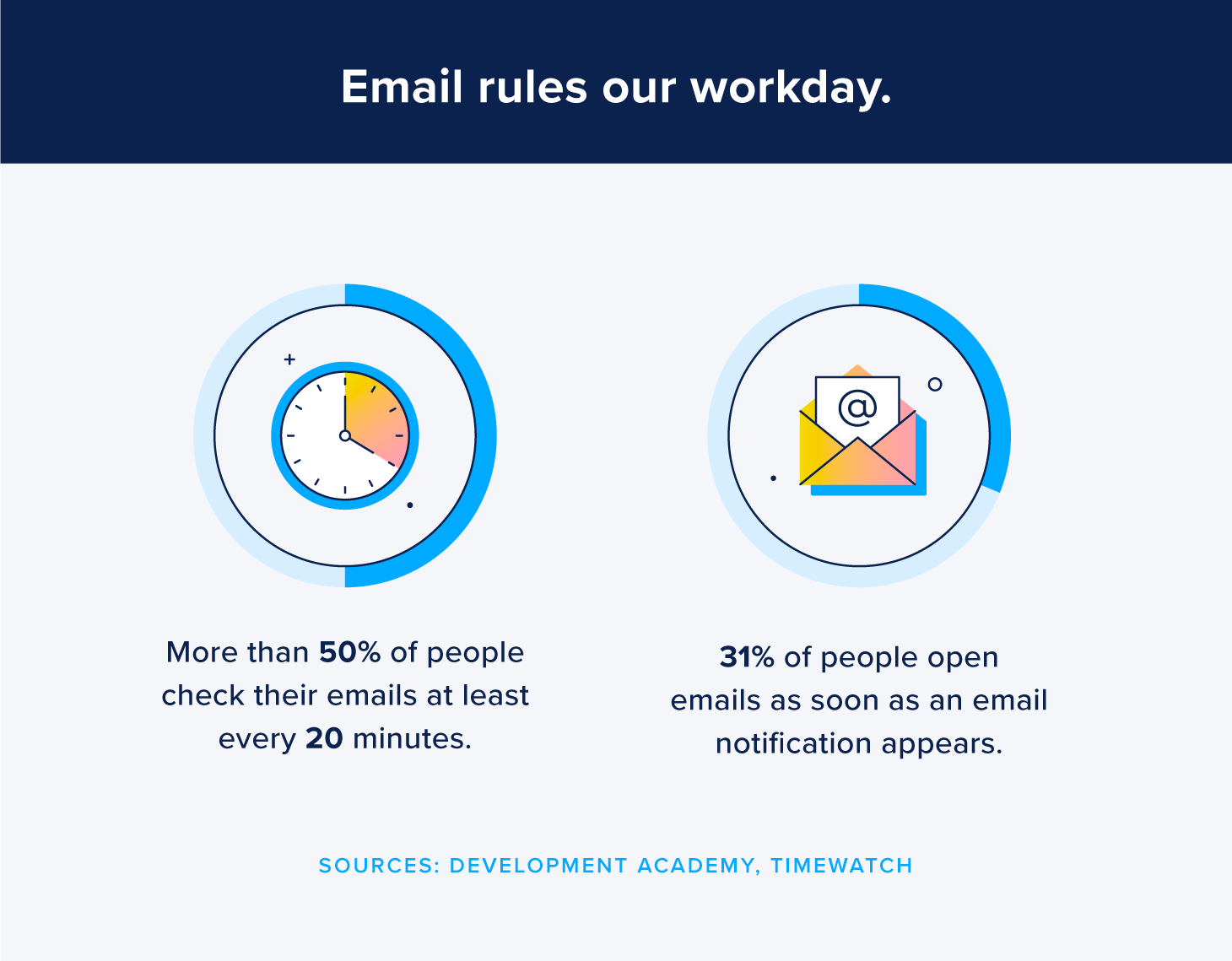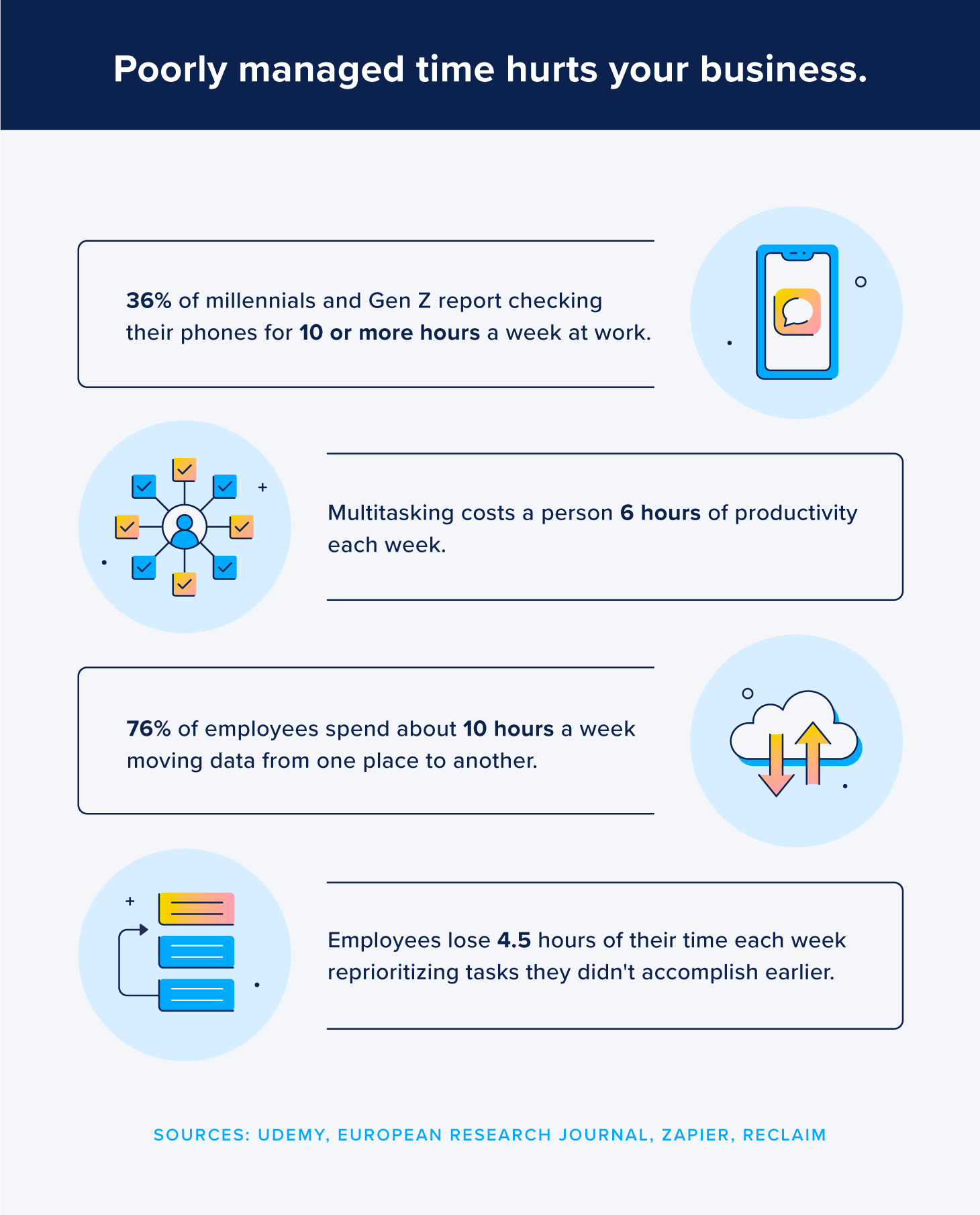42 Time Management Statistics to Inspire Efficiency in 2024

When it comes to time management, it seems everyone has their own system: Some of us use a to-do list, while others use sticky notes on their computer monitor. Still others use a complicated system only they seem to understand, and some just deal with whatever seems most pressing at the moment. No matter what you do, time management statistics agree on one thing: If your employees struggle with time management, it costs your business money.
No matter what business you’re in, it seems people are busier than ever: A study by Reclaim found that 23.4% of people believe the Great Resignation has increased their workload, leading 78.7% of people to report feeling stressed at work.
It’s clear, then, why time management is essential — in a world that only gets busier, we need tried-and-true systems for prioritizing tasks and moving them from the “in progress” bucket to the “completed” pile to keep business growing.
Unfortunately, time management statistics show people don’t know how to manage their time effectively, with Zapier reporting that 35% of employees list time management as the most significant obstacle to their productivity. Finding a way to help your employees better manage their time is important to your bottom line.
Read on to discover the truth about how time management impacts your employees’ daily schedules and your company. We’ve also included a free template to help you better manage your time.
General time management statistics
Let’s start with a few basic statistics to wrap our heads around the state of time management:
1. 58% of American workers say they are so busy with daily tasks that they lack time to consider anything but their to-do list for today. (WorkFront)
2. The typical employee is only productive for 2 hours and 53 minutes per workday. (VoucherCloud)
3. 88% of people use some iteration of a to-do list, whether they create it on paper, as a schedule in their calendar, as a priority list, or in their email inbox. (TimeWatch)
4. Women seem more productive than men: They are assigned 54.9% of tasks at work, yet complete 10% more work than their male counterparts. (Hive)
5. Gen Zers handle distractions better than any other generation group: Chatting with a coworker increased productivity for half of Gen Zers, while 60% of baby boomers need a quiet workspace. (PR Newswire)

Time management at work statistics
Now let’s focus on what’s happening with time management at work. It doesn’t matter what level you are: Employee time management (whether scheduled hourly or not) and manager time management is impeded by the same issues: time spent in meetings that aren’t important, emails, and procrastination.
6. People complete 66% of their assigned tasks at work. (Hive)
7. 88% of workers acknowledge spending at least an hour per day procrastinating at work. (Darius Foroux)
8. About 66% of workers report feeling in control of their work at least 3 days a week. (Development Academy)
9. People spend an average of 1.5 hours (91 minutes) per day on tasks and meetings unrelated to their jobs. (Development Academy)
10. 60% of people believe meetings are a distraction from “real work.” (Udemy)
11. People check their email on average every hour and 40 minutes, although this varies widely depending on how vital a work tool email is. (Development Academy)
12. More than 50% of people check their emails every 20 minutes. (Development Academy)
13. 31% of people open emails as soon as an email notification appears. (TimeWatch)
14. Emails distract more than 63% of employees from their tasks at work. (TimeWatch)
15. When using a time tracking system to report how they spend their workday, nearly 40% of professional service employees said they never keep track of the time they spend reading and responding to emails. (Affinity Live)
16. 90% of employees check business messaging tools like Slack or Teams for up to 5 hours daily. (Zapier)
17. Every company fails to bill 700 hours annually due to employees improperly (or not at all) tracking time spent on email or in meetings. (Affinity Live)

Statistics on methods for time management
The most popular time management method is a to-do list, but the most effective is the Eisenhower Matrix.
18. Of people who report using a time management strategy, 38% use a to-do list, 23% use a calendar, 14% do whatever they think is most important, 13% use email, and 5% use time blocking. (TimeWatch)
19. 73% of people who use a to-do list to manage their time report that it is calming. (Microsoft)
20. Women are more likely than men to prioritize their list by what is most important (85% vs. 78%) or least enjoyable (56% vs. 46%). (Microsoft)
21. 20% of men believe they can manage their time in their heads rather than with a to-do list. Comparatively, only 9% of women believe this. (Microsoft)
22. 50% of people who use the Eisenhower Matrix to manage their time report feeling in control of their work daily, making it the most effective time management system. (Development Academy)
23. 60% of Pomodoro Technique users feel they have control over their workload 4-5 days a week, making it the second most effective time management system. (Development Academy)
24. A quarter of the population “just deals with whatever seems most important at the time” at work. (Development Academy)
25. Of the people who “deal with whatever seems most important at the time,” more than 25% feel their work is under control only 1 day a week or not at all, making it the least effective time management strategy. (Development Academy)
Statistics on poor time management
Sadly, time management isn’t always done well. The effects of poor time management include wasted time, lost productivity, and loss of revenue.
26. 36% of millennials and Gen Z report checking their phones for 10 or more hours a week at work. (Udemy)
27. Employees report their biggest workplace distractions to be social coworkers (80%) and office noise (70%). (Udemy)
28. 39% of people report multitasking during virtual meetings to complete unfinished tasks. (Microsoft)
29. 36% of multitaskers report they become inattentive in remote meetings and miss important information. (Microsoft)
30. Employee multitasking reduces organizations’ productivity by 27.5%. (Realization)
31. Multitasking costs a person 6 hours of productivity each week. (European Research Journal)
32. 14.6% of workers report that their manager is ineffective at managing their time, making it the third most common skill managers lack behind team building and providing feedback. (The Predictive Index)
33. 76% of employees claim to spend about 10 hours each week moving data from one place to another. (Zapier)
34. Employees lose 4 hours and 32 minutes of their time each week to reprioritizing to accommodate tasks they didn’t accomplish earlier in the week. (Reclaim)

Statistics on the benefits of time management
Research shows that people know their lack of time management is a problem, and they know fixing it will help them do more than just cross items off their to-do list.
35.91% of people believe more effective time management will reduce their stress at work. (TimeWatch)
36. 90% of people believe time management will make them more productive at work. (TimeWatch)
37. 86% of people believe they’ll have better task attention if they had better time management. (TimeWatch)
38. 83% of people believe time management will improve their decision-making abilities. (TimeWatch)
39. 76% of people believe improving their time management will boost their reputation at work. (TimeWatch)
40. 76% of people claim they are willing to spend between 15 and 30 minutes a day to benefit from better time management. (TimeWatch)
41. The best way to improve your time management is to organize it. Spending 10-12 minutes planning your day results is a daily time savings of almost 2 hours, a 25% improvement in performance and productivity. (The Law of Planning by Brian Tracy)
42. Businesses that can get employees to track their time better can earn a revenue increase of up to 61%. (Affinity Live)

Time management templates
Time management problems and solutions aren’t always easy to navigate because many different factors can cause poor time management. Is it the result of a lack of planning? Or are there too many distractions interfering with your plan?
We recommend finding a system that works for you. We’ve put together four time management templates to help you plan.

You can also do a time audit to see how you are spending your time to determine where you are spending more time than you should. To do a time audit, record every activity you do and the amount of time you spend doing it for a week. At the end of the week, ask yourself a few questions:
- Where are you spending the most time? Do those match your biggest priorities?
- Are there any places where you’re spending too much time that you could scale back?
- What are your biggest distractions from work? How can you eliminate them?
- At what point during your day are you most productive? Least productive?
- Where can technology help you be more efficient?
Take the information you learn from your time audit to set new time management goals and implement a time management system that works for you.
Manage time better with ZoomShift
As our time management statistics show, time is money, especially when you own your own business, so it’s essential to use your time wisely.
Scheduling can be overwhelming when you manage a large team, and mistakes can cost you valuable time to correct, not to mention dealing with employees who are out sick or need to switch shifts.
ZoomShift can help. Sign up for a free trial of our scheduling software to better manage your time and grow your business.
JD enjoys teaching people how to use ZoomShift to save time spent on scheduling. He’s curious, likes learning new things everyday and playing the guitar (although it’s a work in progress).




